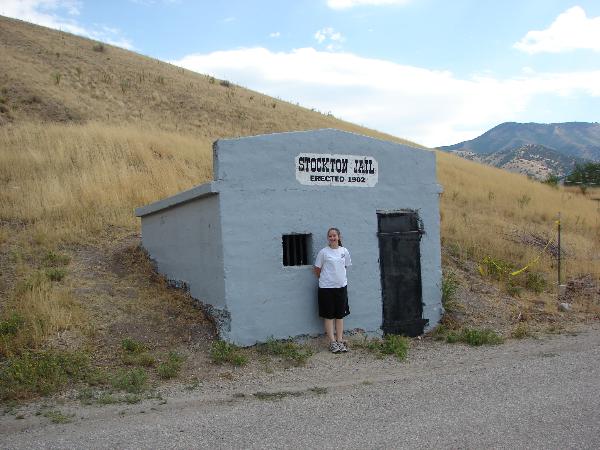
The text on this page is from the nomination form (#85000965) for the National Historic Register, the school was added to the register on May 9, 1985 and is located at 38 West Clark Street in Stockton, Utah.

Built in 1902, the Stockton Jail is historically significant as the only building associated with early law enforcement activities in Stockton and as the best preserved public building dating from the early years of the community. The jail was constructed just one year after the town was incorporated, which was a time of considerable community development that saw a number of civic improvements, including the extension of the railroad lines into the town, construction of a railroad depot, the installation of electricity, surveying of the city cemetery, and dedication of a public square.
The decision to erect a jail in Stockton was made at the town meeting held on September 3, 1902. At that same time Town President E.J. Raddatz appointed James H. Spaulding to serve as Marshall and Street Supervisor, with a salary of fifteen dollars per month. The site selected for the jail is located in the northwest part of town at the base of Tabernacle Hill. The property was purchased in November of 1902 and construction began soon after.
Specifications for the building called for a concrete structure measuring 12 x 14 x 8, with three interior compartments, a metal door, and one small window with iron bars. A stove was installed in the outer or south compartment of the building open its completion. Through the years the building has been used primarily either for detoxification or as temporary shelter for hobos passing through on freight trains.
The Stockton Jail was one of a number of civic improvements that were undertaken in the years immediately following the incorporation of the town in 1901. The Oregon Short Line Railroad extended its tracks into the town in 1902. and in 1904-05 a large depot was built. In 1902 the town Board of Trustees set aside a plot of land as a public square and that same year paid five dollars to A.F. Stookey for surveying the cemetery plot. Electricity was brought to Stockton in 1903 by the Clark Electric Power Company and several street lights were installed at that time. The large, brick and adobe IOOF Hall was erected in 1902, and for many years its upper story was used by the town for recreational purposes, including dances, Christmas parties, and even some school functions. The Stockton Jail is the only building to have survived to the present from that era of intensive community development.
Although Stockton was not incorporated until 1901, it was first established as a community in 1864 when precious ores were discovered in the adjacent mountains by U.S. Army soldiers. The Army had established a camp, Camp Relief, at this site in 1862, and under the direction of Col. Patrick E. Connor the soldiers stationed there began prospecting in the surrounding mountains. Their discovery was probably the first significant mineral discovery in Utah and launched the important mining industry in the state. The town of Stockton, though never the nucleus of mining activity in the area, was one of several important mining towns on the west slope of the Oquirrh Mountains. The town was named after Stockton, California, the one-time home of Col. Patrick Connor.
Because only a few older jails have been identified in Utah, little is known about them – their prevalence, range of sizes and architectural styles, or whether they were generally detached buildings or part of a city hall or county courthouse. Jails that have been identified include the Juab County Jail, a separate building located behind the old courthouse, the Park City Jail, located in the basement of the old city hall, and the Garfield County Jail, adjacent to the county courthouse. The Stockton Jail, unlike those, is in an isolated location at the edge of town and is constructed of concrete.

Pingback: Stockton, Utah | JacobBarlow.com